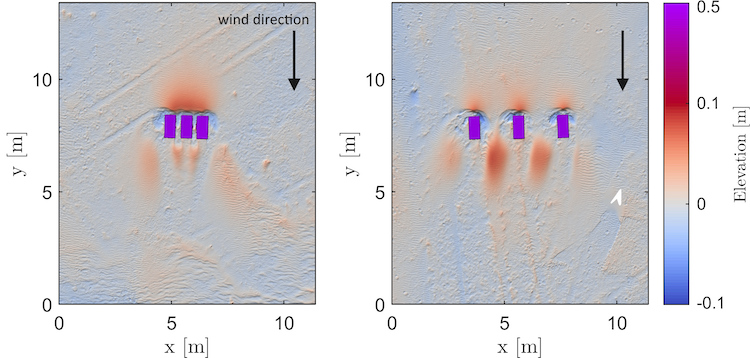D.W. Poppema1*, K.M. Wijnberg1, J.P.M. Mulder1 and S.J.M.H. Hulscher1
1 University of Twente,
Introduction
Buildings at the beach, such as (holiday) houses or restaurants, can shape the development of the beach-dune system by affecting the wind field and wind-driven sand transport in their surroundings. In a recent study (Poppema et al., 2021), we found that buildings create deposition patterns around them, consisting of an upwind deposition area and two downwind deposition tails and with the deposition size depending on the wind-facing surface. However, that study only examined individual buildings that are placed perpendicular to the wind. Along the Dutch coast, buildings are often placed in rows, with a small distance in between buildings. In addition, the wind direction will often be at an oblique angle to a building. Therefore, we conducted a field experiment to determine the effect of building spacing and orientation on the aeolian deposition patterns around buildings.
Methods
During the experiment, cuboid scale models of buildings were placed on the beach at the Sand Motor. To determine the effect of building spacing, scale models were placed in groups of three, with gaps in between scale models ranging from 0 to 4 building widths (see figure 1). To determine the effect of building orientation, individual scale models were placed at various angles to the wind. In total, 34 configurations were tested. The deposition patterns around the scale models were measured after one day using structure-from-motion photogrammetry.
Results
Buildings with a spacing of more than 2 to 3 times the building width created similar deposition patterns as stand-alone buildings. Consequently, the deposition pattern per building group could then simply be regarded as the sum of individual building effects. For smaller gaps, fundamentally different airflow patterns developed, resulting in different deposition patterns behind the gaps, with the exact deposition pattern depending on the gap width. For the building orientation relative to the wind, oblique orientations created an asymmetry in the downwind deposition patterns.

Figure 1: Deposition around two set-ups, with building spacings of 0.5 and 3 times the building width.
References
Poppema, D.W., Wijnberg, K.M., Mulder, J.P.M., Vos, S.E. & Hulscher, S.J.M.H. (2021): The effect of building geometry on the size of aeolian deposition patterns: scale model experiments at the beach, Coastal Engineering: 103866.
I. Surname1*, F.N. Another-Surname2 , Y. Next-Surname2
1 University Name, Country; 2 Organization Name, Country
* Corresponding author: mail.name@organization.org


